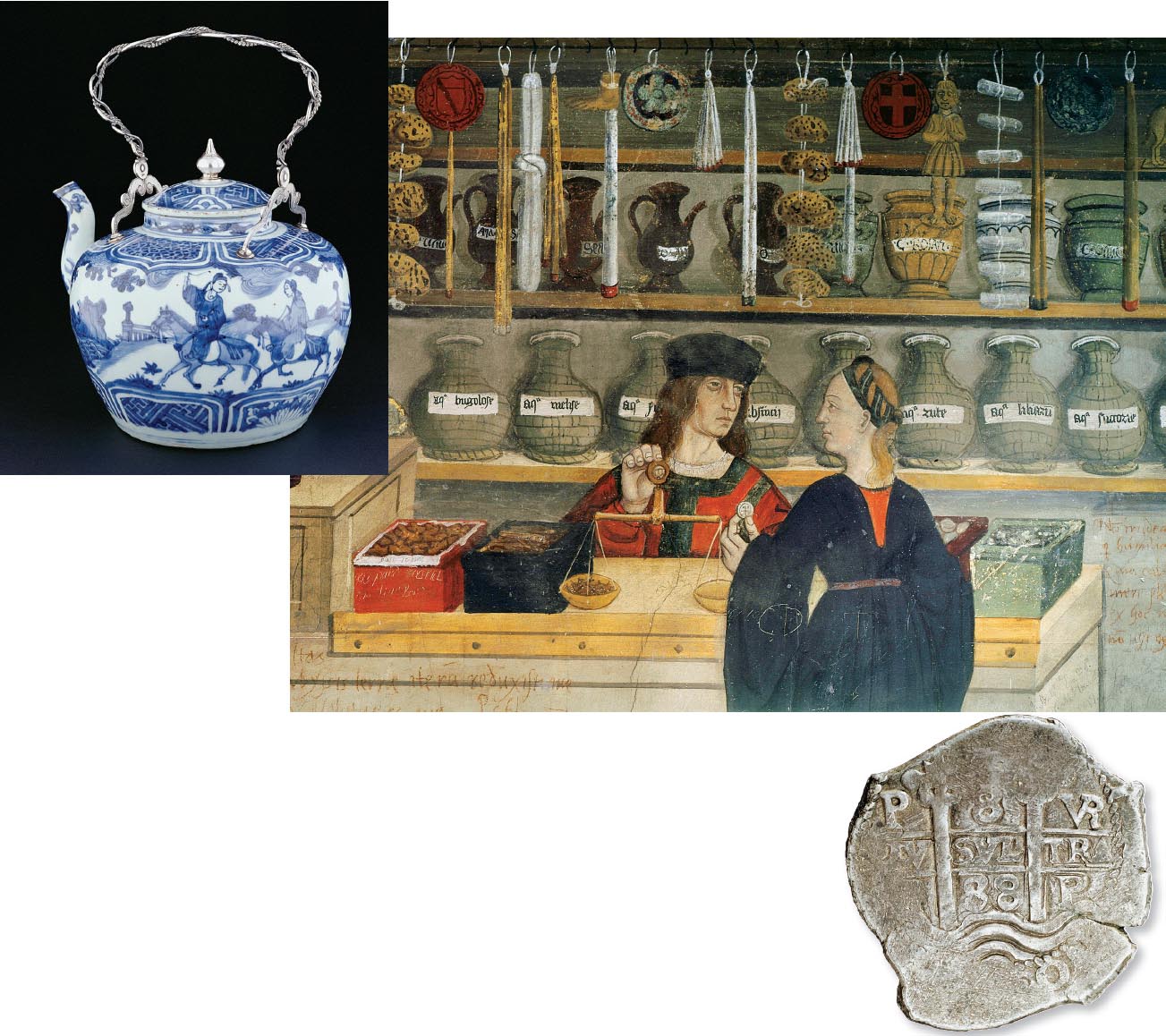The Birth of the Global Economy
With the Europeans’ discovery of the Americas and their exploration of the Pacific, the entire world was linked for the first time in history by seaborne trade. The opening of that trade brought into being three successive commercial empires: the Portuguese, the Spanish, and the Dutch.
The Portuguese were the first worldwide traders. In the sixteenth century they controlled the sea route to India (see Map 14.3). From their fortified bases at Goa on the Arabian Sea and at Malacca on the Malay Peninsula, ships carried goods to the Portuguese settlement at Macao in the South China Sea. From Macao Portuguese ships loaded with Chinese silks and porcelains sailed to the Japanese port of Nagasaki and to the Philippine port of Manila, where Chinese goods were exchanged for Spanish silver from New Spain. Throughout Asia the Portuguese traded in slaves — sub-Saharan Africans, Chinese, and Japanese. The Portuguese exported horses from Mesopotamia and copper from Arabia to India; from India they exported hawks and peacocks for the Chinese and Japanese markets. Back to Portugal they brought Asian spices that had been purchased with textiles produced in India and with gold and ivory from East Africa. They also shipped back sugar from their colony in Brazil, produced by enslaved Africans whom they had transported across the Atlantic.
Coming to empire a few decades later than the Portuguese, the Spanish were determined to claim their place in world trade. The Spanish Empire in the New World was basically a land empire, but across the Pacific the Spaniards built a seaborne empire centered at Manila in the Philippines. The city of Manila served as the transpacific bridge between Spanish America and China. In Manila, Spanish traders used silver from American mines to purchase Chinese silk for European markets. The European demand for silk was so huge that in 1597, for example, 12 million pesos of silver, almost the total value of the transatlantic trade, moved from Acapulco in New Spain to Manila (see Map 14.3). After 1640 the Spanish silk trade declined in the face of stiff competition from Dutch imports.
In the late sixteenth century the Protestant Dutch were engaged in a long war of independence from their Spanish Catholic overlords (see “The Dutch Republic in the Seventeenth Century” in Chapter 15). The joining of the Portuguese crown to Spain in 1580 gave the Dutch a strategic incentive to attack Portugal, a major economic competitor for the Dutch. Drawing on their commercial wealth and determined use of force, the Dutch emerged by the end of the seventeenth century as both a free nation and a worldwide seaborne trading power. The Dutch Empire was initially built on spices. In 1599 a Dutch fleet returned to Amsterdam carrying 600,000 pounds of pepper and 250,000 pounds of cloves and nutmeg. Those who had invested in the expedition received a 100 percent profit. The voyage led to the establishment in 1602 of the Dutch East India Company, founded with the stated intention of capturing the spice trade from the Portuguese.

The Dutch set their sights on gaining direct access to and control of the Indonesian sources of spices. The Dutch fleet sailed from the Dutch Republic to the Cape of Good Hope in Africa and, avoiding the Portuguese forts in India, steered directly for the Sunda Strait in Indonesia (see Map 14.3). In return for assisting Indonesian princes in local squabbles and disputes with the Portuguese, the Dutch won broad commercial concessions. Through agreements, seizures, and outright military aggression, they gained control of the western access to the Indonesian archipelago in the first half of the seventeenth century. Gradually, they acquired political domination over the archipelago itself. By the 1660s the Dutch had managed to expel the Portuguese from Ceylon and other East Indian islands, thereby establishing control of the lucrative spice trade.
Not content with challenging the Portuguese in the Indian Ocean, the Dutch also aspired to a role in the Americas. Founded in 1621, when the Dutch were at war with the Spanish, the Dutch West India Company aggressively sought to open trade with North and South America and capture Spanish territories there. The company captured or destroyed hundreds of Spanish ships, seized the Spanish silver fleet in 1628, and captured portions of Brazil and the Caribbean. The Dutch also successfully interceded in the transatlantic slave trade, establishing a large number of trading stations on the west coast of Africa. Ironically, the nation that was known throughout Europe as a bastion of tolerance and freedom came to be one of the principal operators of the slave trade starting in the 1640s.
Dutch efforts to colonize North America were less successful. The colony of New Netherland, governed from New Amsterdam (modern-day New York City), was hampered by lack of settlement and weak governance and was easily captured by the British in 1664.